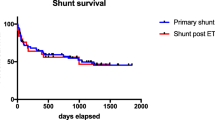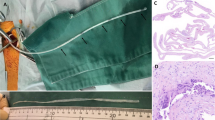Abstract
Purpose
We have discussed the diagnosis and treatment approaches in patients with discontinued (disconnected or fractured) ventriculoperitoneal (VP) shunts that caused mechanical dysfunction.
Methods
Between 2006 and 2016, VP shunt surgery was performed on 1357 pediatric patients in our clinic. In follow-up examinations, we retrospectively reviewed patients who underwent revision surgery. Except for diagnosis of discontinued VP shunt, by excluding revision-surgery patients, only those patients who underwent surgical treatment owing to discontinued (fracture or disconnection) catheter were included in the study. Age at first surgery, sex, reason for shunt discontinuity, anatomical region of pathology, time to discontinuity diagnosis after first surgery, and presence or absence of symptoms were evaluated.
Results
One thousand three hundred fifty-seven VP shunt surgeries were performed in total, with 305 (22.4%) patients requiring revision surgery. Of these 305 patients, after accounting for other complications like obstruction, infection, overdrainage, and so on, 25 (8.1%) patients (14 male, 11 female) required re-surgery due to discontinuity. The mean age of these patients was 5.4 ± 2.1 months during the first VP shunt surgery, and the mean age during revision surgery was 71.7 months. The mean duration until discontinuity was diagnosed was 66.3 ± 24.1 months (76.1 months for catheter fractures and 45.6 months for disconnections (p 0.021)).
Conclusion
Disconnection and fracture are two significant mechanical VP shunt dysfunctions and must be adequately researched and understood even during routine follow-ups. A disconnected or fractured shunt may be working and it is not safe to state that the shunt is no longer needed.



Similar content being viewed by others
References
Aldrich EF, Harmann P (1990) Disconnection as a case of ventriculoperitoneal shunt malfunction in multicomponent shunt systems. Pediatr Neurosurg 16:309–312
Al-Holou WN, Sack JA, Garton HJ, Muraszko KM, Maher CO (2010) Removal of ventricular shunts. Pediatr Neurosurg 46:172–176
Casey AT, Kimmings EJ, Kleinlugtebeld AD, Taylor WA, Harkness WF, Hayward RD (1997) The long-term outlook for hydrocephalus in childhood: a ten-year cohort study of 155 patients. Pediatr Neurosurg 27:63–70
Colak A, Albright AL, Pollack IF (1997) Follow-up of children with shunted hydrocephalus. Pediatr Neurosurg 27:208–210
Drake JM, Kestle JR, Milner R, Cinalli G, Boop F, Piatt J Jr, Haines S, Schiff SJ, Cochrane DD, Steinbok P, MacNeil N (1998) Randomized trial of cerebrospinal fluid shunt valve design in pediatric hydrocephalus. Neurosurgery 43:294–303
Echizenya K, Satoh M, Murai H, Ueno H, Abe H, Komai T (1987) Mineralization and biodegradation of CSF shunting systems. Neurosurgery 67:584–591
Epstein F (1985) How to keep shunts functioning, or “the impossible dream”. Clin Neurosurg 32:608–631
Griebel R, Khan M, Tan L (1985) CSF shunt complications: an analysis of contributory factors. Childs Nerv Syst 1:77–80
Haase J, Bang F, Tange M (1987) Danish experience with the one-piece shunt. A long-term follow-up. Childs Nerv Syst 3:93–96
Iannelli A, Rea G, Di Rocco C (2005) CSF shunt removal in children with hydrocephalus. Acta Neurochir 147:503–507
Iskandar BJ, Tubbs S, Mapstone TB, Grabb PA, Bartolucci AA, Oakes WJ (1998) Death in shunted hydrocephalic children in the 1990s. Pediatr Neurosurg 25:173–176
Kang JK, Lee IW (1999) Long-term follow-up of shunting therapy. Childs Nerv Syst 15:711–717
Kaplan M, Cakin H, Ozdemir N, Gocmez C, Ozturk S, Erol FS (2012) Is the elapsed time following the placement of a ventriculoperitoneal shunt catheter an individual risk factor for shunt fractures? Pediatr Neurosurg 48:348–351
Longatti PL, Carteri A (1994) Active singling out of shunt independence. Childs Nerv Syst 10:334–336
Lundar T (1994) Shunt removal or replacement based on intraventricular infusion tests. Childs Nerv Syst 10:337–339
May CH, Aurisch R, Kornrumpf D, Vogel S (1999) Evaluation of shunt function in hydrocephalic patients with the radionuclide 99mTc-pertechnetate. Childs Nerv Syst 15:239–244
Park MK, Kim M, Park KS, Park SH, Hwang JH, Hwang SK (2015) A retrospective analysis of ventriculoperitoneal shunt revision cases of a single institute. J Korean Neurosurg Soc 57:359–363
Raimondi AJ, Robinson JS, Kuwawura K (1977) Complications of ventriculo-peritoneal shunting and a critical comparison of the three-piece and one-piece systems. Childs Brain 3:321–342
Reddy GK, Bollam P, Caldito G, Guthikonda B, Nanda A (2012) Ventriculoperitoneal shunt surgery outcome in adult transition patients with pediatric-onset hydrocephalus. Neurosurgery 70:380–388
Sgouros S, Mallucci C, Walsh AR, Hockley AD (1995) Long-term complications of hydrocephalus. Pediatr Neurosurg 23:127–132
Takahashi Y (2001) Withdrawal of shunt systems—clinical use of the programmable shunt system and its effect on hydrocephalus in children. Childs Nerv Syst 17:472–477
Uvebrant P, Sixt R, Bjure J, Roos A (1992) Evaluation of cerebrospinal fluid shunt function in hydrocephalic children using 99mTc-DTPA. Childs Nerv Syst 8:76–80
Vinchon M, Fichten A, Delestret I, Dhellemmes P (2003) Shunt revision for asymptomatic failure: surgical and clinical results. Neurosurgery 52:347–353
Zhao R, Shi W, Yang H, Li H (2016) Endoscopic third ventriculostomy instead of shunt revision in children younger than 3 years of age. World Neurosurg 88:92–96
Author information
Authors and Affiliations
Corresponding author
Ethics declarations
Conflict of interest
On behalf of all authors, the corresponding author states that there is no conflict of interest.
Rights and permissions
About this article
Cite this article
Erol, F.S., Ozturk, S., Akgun, B. et al. Ventriculoperitoneal shunt malfunction caused by fractures and disconnections over 10 years of follow-up. Childs Nerv Syst 33, 475–481 (2017). https://doi.org/10.1007/s00381-017-3342-0
Received:
Accepted:
Published:
Issue Date:
DOI: https://doi.org/10.1007/s00381-017-3342-0




